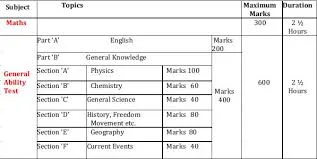Master the NDA Exam: Syllabus, Sections & Smart Strategy"
Master the NDA Exam: Syllabus, Sections & Smart Strategy"
The exam is split into major papers
Topics Covered
General Ability Test (Paper II)
Key Areas Covered
General Knowledge (400 Marks)
The National Defence Academy (NDA) exam is one of the maximum prestigious and competitive checks performed with the aid of the Union Public Service Commission (UPSC) in India. The NDA exam is held twice a year and is open to male and woman candidates who've finished or are performing of their 12th widespread.
NDA Exam Syllabus
The exam is split into major papers:
Mathematics
General Ability Test (GAT)
Let’s damage down every section in element.
1. Mathematics (Paper I)
Duration: 2.5 hours
Maximum Marks: 300
The Mathematics section of the NDA syllabus is designed to check a candidate’s analytical and problem-solving competencies. The questions are of 10+2 level and cowl a huge variety of topics:
Topics Covered:
1. Algebra
Set theory, Venn diagrams
Operations on sets
Complex numbers – primary houses, modulus, argument
Quadratic equations and roots
Arithmetic and geometric development
Logarithms and their applications
Linear equations, simultaneous equations
Binomial theorem and its packages
Permutations and mixtures
2. Matrices and Determinants
Types of matrices
Operations on matrices
Determinant of a matrix
Inverse of a matrix
Applications in solving linear equations (Cramer’s Rule)
three. Trigonometry
Angles and their measurements
Trigonometric ratios and identities
Height and distance troubles
Properties of triangles
Inverse trigonometric features
Applications of trigonometry in actual existence
four. Analytical Geometry (2D and 3-D)
Cartesian coordinate system
Straight traces, distance, and segment formulas
Conic sections: circles, parabolas, ellipses, hyperbolas
3D geometry: direction cosines, direction ratios
Lines and planes in area
Sphere and its equations
five. Differential Calculus
Functions and boundaries
Continuity and differentiability
Derivatives and their packages
Maxima and minima
Increasing and reducing functions
6. Integral Calculus
Indefinite integrals
Definite integrals and their properties
Application of integrals in calculating place and quantity
7. Vector Algebra
Addition and subtraction of vectors
Scalar and vector merchandise
Applications in physics and geometry
8. Statistics and Probability
Measures of central tendency: mean, median, mode
Variance and general deviation
Elementary opportunity principle
Bayes’ theorem and simple chance troubles
2. General Ability Test (Paper II)
Duration: 2.Five hours
Maximum Marks: six hundred
The General Ability Test evaluates a candidate’s English talent, preferred knowledge, technology information, and modern affairs consciousness.
Part A: English (2 hundred Marks)
This segment assesses the candidate's grasp over the English language in phrases of vocabulary, grammar, and comprehension.
Key Areas Covered:
Grammar and utilization
Vocabulary
Synonyms and antonyms
Comprehension and reading abilities
Sentence association
Fill inside the blanks
Spotting the error
Idioms and phrases
Para jumbles
Active and passive voice
Direct and indirect speech
The goal is to test the candidate’s fundamental know-how of English in both written and spoken forms.
Part B: General Knowledge (400 Marks)
This section checks a candidate’s focus of fashionable science, history, geography, and modern-day affairs. It is subdivided into six components:
1. Physics
Properties of remember and sound
Heat, mild, and optics
Magnetism and power
Motion of items
Current energy and electrostatics
Nuclear physics and radioactivity
Basic electronics and electromagnetism
2. Chemistry
Elements, compounds, and combos
Atomic shape and chemical bonding
States of be counted: solids, drinks, gases
Acids, bases, salts, and their properties
Chemical equations and laws
Carbon and its compounds
Metals, non-metals, and their reactions
Environmental chemistry and makes use of in day by day life
three. General Science
Human frame: organs and their capabilities
Diseases and preventive measures
Nutrition and balanced weight loss plan
Living and non-dwelling things
Reproduction in animals and plants
Biotechnology and genetics
Environmental pollutants and weather exchange
four. History, Freedom Movement, and Culture
Ancient, medieval, and cutting-edge Indian history
Nationalist movement and vital leaders
Independence warfare
Constitution of India and key tendencies
Cultural heritage and monuments
Important revolutions and battles
5. Geography
Earth structure and surroundings
Mountains, rivers, lakes
Natural flowers and flora and fauna
Climate, climate, and soils of India
World geography: continents, oceans
Economic geography: agriculture, industries, shipping
Geographical functions of India
6. Current Events and Affairs
Recent country wide and global occasions
Sports and video games
Important authorities schemes and policies
Awards and honors
Defense and army physical games
International companies (UN, WHO, etc.)
NDA Exam Pattern Summary
Paper Subject Duration Marks
Paper I Mathematics 2.Five Hours 300
Paper II General Ability Test 2.Five Hours six hundred
Total (Written) 900
SSB Interview Personality + Medical Varies 900
Grand Total 1800
SSB Interview (900 Marks)
Candidates who clear the written check are referred to as for the SSB Interview, which consists of:
Stage 1: Screening Test (which include OIR - Officer Intelligence Rating, and PPDT - Picture Perception & Description Test)
Stage 2: Psychological Tests, GTO Tasks (Group Testing Officer), Personal Interview, and Conference
This stage evaluates a candidate’s persona, leadership talents, self belief, conversation skills, and bodily & mental health.
Preparation Tips Based on Syllabus
Build Basics: Focus on knowledge fundamental principles in math, technology, and grammar. NCERT books (Class 6 to twelve) are incredible for this.
Time Management: Solve mock assessments and beyond yr papers to enhance speed and accuracy.
Current Affairs: Stay up to date via newspapers, magazines, and on line structures.
Physical Fitness: Begin light exercises and stamina-building activities to put together for SSB and physical exams.
Smart Revision: Use precis notes and formulation sheets for brief revision, specifically in mathematics and GK.


.jpg)
.jpg)
.jpg)
Revise Regularly with Notes:
ReplyDeleteMake concise notes and revise frequently to retain formulas, facts, and key events.
Prepare for SSB Alongside:
While studying for the written exam, also develop communication skills, general awareness, and physical fitness for the SSB interview.